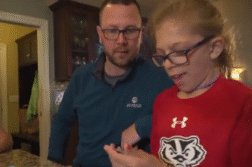LOS ANGELES, Calif. (Ivanhoe Newswire) – Every year more than 250,000 will be told they have a blood clot. On average, 274 people die every day from one. But did you know, it’s not just an adult problem. In fact, one in ten kids who are admitted into the hospital will develop a blood clot. Now, a new kid-friendly drug is being tested to help get rid of blood clots without using a needle.
A blood clot, it’s a gel or solid clump of blood in your veins or arteries. They can form almost anywhere in your body and can be fatal.
“I had a blood clot where my ear was at and they had to take it out,” Brandy Sanchez, 14, told Ivanhoe.
Sanchez was in the hospital when she developed a blood clot.
“My head really hurt,” she described.
Sanchez was given two injections a day of the common blood thinner Enoxaparin.
“I didn’t like the needles at all,” Sanchez said.
Pediatric hematologist and director of the Hemostasis and Thrombosis Center at Children’s Hospital Los Angeles, Guy Young, MD, often sees kids like Sanchez struggle with treatment. Until now, infants and children would receive anticoagulant injections to ensure precise dosing.
“What we really needed in children was better drug options,” Young said.
Dr. Young led a clinical trial testing a new liquid alternative, Rivaroxaban. The main difference: precise dosing with no needles.
“Children come in lots of different sizes, so we can’t, it’s not a one-size-drug fits all,” Young said.
With Warfarin, weekly blood tests are needed to check levels since hundreds of drugs interact with Warfarin. Not so with Rivaroxaban. Sanchez has battled her blood clots and has won: no more needles, no more medication and no more blood clots.
Rivaroxaban is FDA approved for patients 18 years and older. Bayer, which makes the drug, hopes to get FDA approval by 2021 for the use in infants and children under 18 within the next year.
Contributors to this news report include: Marsha Lewis, Producer; Rusty Reed, Videographer; Matt Goldschmidt, Editor.
To receive a free weekly e-mail on Medical Breakthroughs from Ivanhoe, sign up at: http://www.ivanhoe.com/ftk
MEDICAL BREAKTHROUGHS
RESEARCH SUMMARY
TOPIC: BUSTING BLOOD CLOTS IN KIDS
REPORT: MB #4714
BACKGROUND: Thrombosis is a blood clot, parts of the blood form together to create a seal for a wound, but there can be chemical changes in the blood that cause this clot to happen, which stops the flow of blood in a vessel. This is a serious issue, especially when a clot blocks a major vain or artery. There are three usual forms of blood clots, which are deep vein thrombosis (DVT,) cerebral sinovenous thrombosis, and pulmonary embolism (PE). DVT is when there is a clot in a large vein inside the body. Symptoms include sudden swelling, soreness, or pain in an area of the body, or change of skin color to red, pale, or bluish skin, or coolness or warmth over an area. For cerebral sinovenous thrombosis, the main symptom is a severe headache that is unusual and causes blurred vision. For PE, symptoms for a blood clot may be breathing difficulty, chest pain, fast heartbeat, sweating, coughing, fever, or fainting.
(Source: http://www.danafarberbostonchildrens.org/conditions/blood-disorders/thrombosis.aspx)
DIAGNOSIS: Imaging is done when thrombosis is suspected in a child. This may be in the form of a physical exam, an ultrasound, which uses high frequency sound waves and their echoes, an MRI (Magnetic resonance imaging,) which uses a large magnet and radio waves via a computer, a CAT scan, which uses x-ray equipment, blood samples, or a genetic test to see if it is a hereditary disorder.
(Source: http://www.danafarberbostonchildrens.org/conditions/blood-disorders/thrombosis.aspx)
TREATMENT: Currently, doctors prescribe the blood thinner, Warfarin, which comes in tablet form. Since a side effect is that it increases the risk of bleeding, there still have to be regular blood checks for the level of Warfarin. If it’s too high, the risk for bleeding gets very high. If it’s too low, the patient is not being treated. There must be blood tests run once a week every two weeks.
(Source: https://www.drugs.com/warfarin.html)
RIVAROXABAN: Doctors at Children’s Hospital Los Angeles have created a new prescription drug that is easier to take, doesn’t interfere with other drugs, and doesn’t require blood tests as often. Rivaroxaban, also known as Xarelto, comes in liquid form and a dosage is prescribed according to age group. Rivaroxaban is FDA approved for patients 18 years and older. It is not approved at this point in time for children.
(Source: https://www.webmd.com/drugs/2/drug-156265-1153/xarelto-oral/rivaroxaban-oral/details)
FOR MORE INFORMATION ON THIS REPORT, PLEASE CONTACT:
Lauren Song
If this story or any other Ivanhoe story has impacted your life or prompted you or someone you know to seek or change treatments, please let us know by contacting Marjorie Bekaert Thomas at mthomas@ivanhoe.com



